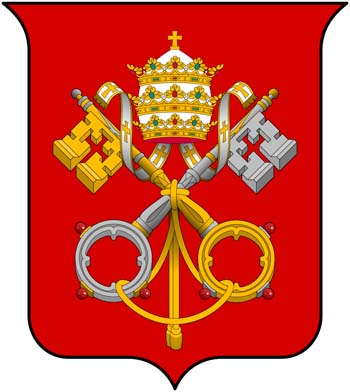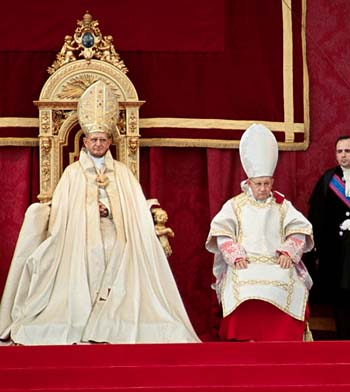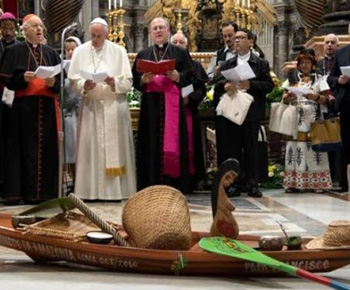About the Church
 |
 |
 |
 |
 |
 |
 |
The Authority of Pontifical & Conciliar Documents – V
Are the Documents of Vatican II Infallible?
At this point, a question naturally rises in the reader’s mind: Did the Vatican Council II use the prerogative of infallibility?
The answer is simple and categorical: No. At no time did the Conciliar Fathers have the will to define, that is, at no time did they fulfill the third of the conditions of infallibility indicated before (here and here).
Already in the preparatory phase of the Conciliar Assembly, Holy Father John XXIII declared that it would not define new dogmas, but would only have a pastoral character. This statement of John XXIII, however, does not seem to us sufficient to warrant the affirmation that the Council did not use its power to define.
 Indeed, the Pope's sovereignty is absolute in the Catholic Church. He is above all ecclesiastical laws. His power has no limits except those of Divine Law and Natural Law. Any pontifical act contrary to these laws would be void, but no Council and no previous law, enacted either by himself or his Predecessors, can oblige the reigning Pope. Therefore, nothing prevents the possibility that, after having convened a pastoral council, John XXIII or his Successor could later decide to turn it into a dogmatic council.
Indeed, the Pope's sovereignty is absolute in the Catholic Church. He is above all ecclesiastical laws. His power has no limits except those of Divine Law and Natural Law. Any pontifical act contrary to these laws would be void, but no Council and no previous law, enacted either by himself or his Predecessors, can oblige the reigning Pope. Therefore, nothing prevents the possibility that, after having convened a pastoral council, John XXIII or his Successor could later decide to turn it into a dogmatic council.
On the other hand, in principle nothing prevents a pastoral council from defining a dogma, for no Catholic would dare to sustain that a dogma is something anti-pastoral!
The proof that Vatican II did not want to define any dogma is in its minutes and the content of its documents, none of which clearly expresses the will to define.
The declaration of March 6, 1964, of the Council’s Doctrinal Commission (1) confirms this point. This statement is of great importance not only because its content was later repeated by the same Commission (2), and officially applied to more than one schema (3), but above all because Pope Paul VI indicated it as the norm for the interpretation of the whole Council. (4) Some theologian might disagree with what we have just affirmed but for the fact that several other pronouncements by Pope Paul VI would definitively and irrevocably settle this important question.
At the close of the Council, Paul VI declared that in it “the Magisterium of the Church ... did not want to pronounce any extraordinary dogmatic sentence.” (5)
 Subsequently, on less solemn occasions but even more clearly and precisely, Paul VI reaffirmed that the Council “avoided proclaiming in an extraordinary way dogmas endowed with the note of infallibility,” but rather “conferred on its teachings the authority of the supreme Ordinary Magisterium.” (6) He further stated that one of its programmatic points was “to not give new solemn dogmatic definitions.” (7)
Subsequently, on less solemn occasions but even more clearly and precisely, Paul VI reaffirmed that the Council “avoided proclaiming in an extraordinary way dogmas endowed with the note of infallibility,” but rather “conferred on its teachings the authority of the supreme Ordinary Magisterium.” (6) He further stated that one of its programmatic points was “to not give new solemn dogmatic definitions.” (7)
A Council only has the authority that the Pope wants to give it. Thus, these pontifical pronouncements, subsequent to the promulgation of the conciliar documents, put an end to all doubts that might subsist.
In an article published in 1965 in the Brazilian Ecclesiastical Magazine [Revista Eclesiastica Brasileira], Bishop Boaventura Kloppenburg analyzed the problem of the theological qualification of the Conciliar Constitution Lumen gentium and declared that he “was inclined to conclude that all truths data opera proposed as doctrines revealed by Lumen gentium are in fact solemnly defined truths of faith.“ (8) After Paul VI's quoted pronouncements, such a judgment can no longer be upheld. (9)
One document of Vatican Council II on the Church is entitled “Dogmatic Constitution.” Can one deduce from this that there is any definition of dogma in it? The question may appear superfluous, but we raise it to warn the reader against an error into which some have fallen. We even heard that a theology professor who studied the question firmly stated that the title “Dogmatic Constitution” is sufficient to prove that everything in Lumen gentium is dogma.
Of course, in this case the adjective “dogmatic” only means that it concerns a matter related to dogma. In the same way, not everything one reads in a manual of dogmatic theology is dogma.
Let us not, therefore, give Vatican II an assent that the Council itself has not requested from us. Let us, however, heed its teachings to the full extent of the authority they have, even understanding that, insofar as they expand upon the earlier teachings of the Church, they can be important factors in establishing infallibility by continuing the same teaching.
Thinking with the Church
Stunned, the Catholic world daily witnesses new acts of indiscipline on the part of progressivists against the Magisterium of the Church… They continuously incite all Catholics to abandon the traditional Church doctrine, including points that are guaranteed by the mark of infallibility. In the face of such danger, let us stand firm in the faith, ever ready to render to the ecclesiastical Magisterium the utmost compliance, with the external and internal assent that faith has the right to expect from us.
 For this, it is essential to know the Church’s doctrine about its own teaching, of which this series could only present some general lines.
For this, it is essential to know the Church’s doctrine about its own teaching, of which this series could only present some general lines.
In this way we can better understand, admire and follow what St. Ignatius in his Rules for Thinking with the Church sets out regarding the ecclesiastical Magisterium. We transcribe the words of the Saint, asking Our Lady, Mother of the Church, to inspire in all her children a docile, enthusiastic and perfect submission to the See of Peter:
“First rule – Renouncing all self-judgment, we must be wholly willing to obey in all things the true Spouse of Jesus Christ Our Lord, which is our Hierarchical Holy Mother Church.”
“Ninth rule – Finally, to praise all precepts of the Church, always seeking reasons in their favor, and never in their disfavor.”
“Thirteenth rule – To always be on the side of truth, we must follow this norm: the white that I see is black, if the Holy Church so decides it, believing that between Christ Our Lord, the Bridegroom, and the Church, his Bride, there is the same Spirit that governs and directs us for the salvation of our souls. In fact, the same Divine Spirit who gave us the Ten Commandments also rules and governs our Holy Mother Church. “

The answer is simple and categorical: No. At no time did the Conciliar Fathers have the will to define, that is, at no time did they fulfill the third of the conditions of infallibility indicated before (here and here).
Already in the preparatory phase of the Conciliar Assembly, Holy Father John XXIII declared that it would not define new dogmas, but would only have a pastoral character. This statement of John XXIII, however, does not seem to us sufficient to warrant the affirmation that the Council did not use its power to define.

The gold key in the papal coat of arms refers to the Pope's direct authority in the spiritual sphere, the silver to his indirect authority in the temporal sphere
On the other hand, in principle nothing prevents a pastoral council from defining a dogma, for no Catholic would dare to sustain that a dogma is something anti-pastoral!
The proof that Vatican II did not want to define any dogma is in its minutes and the content of its documents, none of which clearly expresses the will to define.
The declaration of March 6, 1964, of the Council’s Doctrinal Commission (1) confirms this point. This statement is of great importance not only because its content was later repeated by the same Commission (2), and officially applied to more than one schema (3), but above all because Pope Paul VI indicated it as the norm for the interpretation of the whole Council. (4) Some theologian might disagree with what we have just affirmed but for the fact that several other pronouncements by Pope Paul VI would definitively and irrevocably settle this important question.
At the close of the Council, Paul VI declared that in it “the Magisterium of the Church ... did not want to pronounce any extraordinary dogmatic sentence.” (5)

Paul VI at the Council's closing announces the Council did not pronounce any dogma
A Council only has the authority that the Pope wants to give it. Thus, these pontifical pronouncements, subsequent to the promulgation of the conciliar documents, put an end to all doubts that might subsist.
In an article published in 1965 in the Brazilian Ecclesiastical Magazine [Revista Eclesiastica Brasileira], Bishop Boaventura Kloppenburg analyzed the problem of the theological qualification of the Conciliar Constitution Lumen gentium and declared that he “was inclined to conclude that all truths data opera proposed as doctrines revealed by Lumen gentium are in fact solemnly defined truths of faith.“ (8) After Paul VI's quoted pronouncements, such a judgment can no longer be upheld. (9)
One document of Vatican Council II on the Church is entitled “Dogmatic Constitution.” Can one deduce from this that there is any definition of dogma in it? The question may appear superfluous, but we raise it to warn the reader against an error into which some have fallen. We even heard that a theology professor who studied the question firmly stated that the title “Dogmatic Constitution” is sufficient to prove that everything in Lumen gentium is dogma.
Of course, in this case the adjective “dogmatic” only means that it concerns a matter related to dogma. In the same way, not everything one reads in a manual of dogmatic theology is dogma.
Let us not, therefore, give Vatican II an assent that the Council itself has not requested from us. Let us, however, heed its teachings to the full extent of the authority they have, even understanding that, insofar as they expand upon the earlier teachings of the Church, they can be important factors in establishing infallibility by continuing the same teaching.
Thinking with the Church
Stunned, the Catholic world daily witnesses new acts of indiscipline on the part of progressivists against the Magisterium of the Church… They continuously incite all Catholics to abandon the traditional Church doctrine, including points that are guaranteed by the mark of infallibility. In the face of such danger, let us stand firm in the faith, ever ready to render to the ecclesiastical Magisterium the utmost compliance, with the external and internal assent that faith has the right to expect from us.

Pope Francis shocks Catholics when he prays before a pagan goddess at St. Peter Basilica
In this way we can better understand, admire and follow what St. Ignatius in his Rules for Thinking with the Church sets out regarding the ecclesiastical Magisterium. We transcribe the words of the Saint, asking Our Lady, Mother of the Church, to inspire in all her children a docile, enthusiastic and perfect submission to the See of Peter:
“First rule – Renouncing all self-judgment, we must be wholly willing to obey in all things the true Spouse of Jesus Christ Our Lord, which is our Hierarchical Holy Mother Church.”
“Ninth rule – Finally, to praise all precepts of the Church, always seeking reasons in their favor, and never in their disfavor.”
“Thirteenth rule – To always be on the side of truth, we must follow this norm: the white that I see is black, if the Holy Church so decides it, believing that between Christ Our Lord, the Bridegroom, and the Church, his Bride, there is the same Spirit that governs and directs us for the salvation of our souls. In fact, the same Divine Spirit who gave us the Ten Commandments also rules and governs our Holy Mother Church. “
- Cf. L’Osservatore Romano, French ed., December 18, 1964, p. 10.
- Ibid.
- Cf. L’Osservatore Romano, French ed., November 26, 1965, p. 3.
- Paul VI, Speech in the General Audience of December 1, 1966, in Revista Eclesiástica Brasileira, 1966, fasc. 1, pp. 169-171.
- Paul VI, Closing Speech of the Ecumenical Council Vatican II, in Concílio Vaticano II, Madrid: B.A.C., 1965, pp. 817.
- Paul VI, Speech of December 1, 1966, p. 170.
- Paul VI, Speech in the General Audience of March 8, 1967, in L'Osservatore Romano," Argentine daily ed., March 21, 1967.
- Boaventura Kloppenburg, "Subsídios para a qualificação teológica da Lumen Gentium," in Revista Eclesiástica Brasileira, 1965, fase. 2, pp. 209-219.
- "Renovatio," Review of theology and culture, Genova, 1967, n. 2; Cirilo Folch Gomes, "A revelação divina," in Revista Eclesiástica Brasileira, 1966, fasc. 4, pp. 816-837; Henri de LaValette, "Réflexion sur la portée doctrinale et pastorale des documents du Vatican II," in Etudes, September 1966, pp. 258-269.

First published in Catolicísmo, n.. 202, October 1967
Posted November 20, 2019
Posted November 20, 2019















